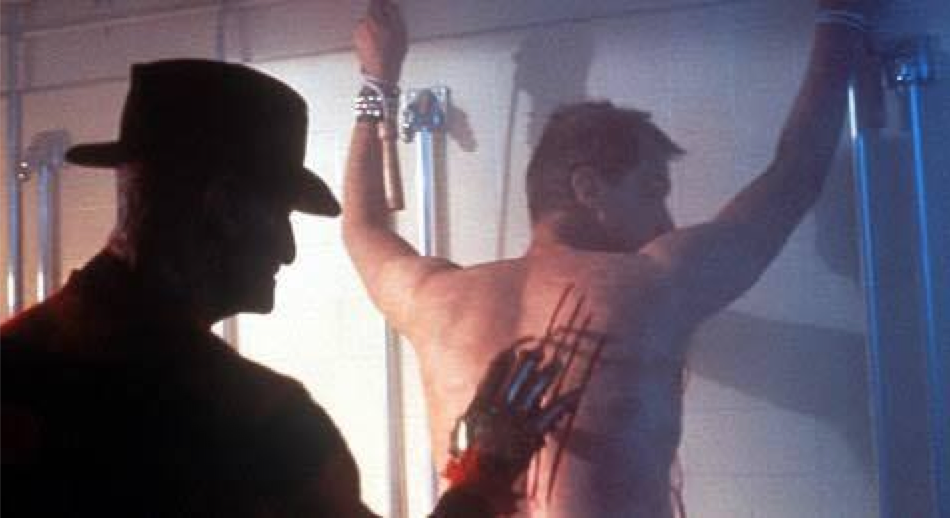Is Nightmare On Elm Street 2 An Accidental Queer Classic?
By Joseph Earp
Let’s get one thing straight – Nightmare On Elm Street 2: Freddy’s Revenge is not a good movie. It has no concept of the word ‘good’. ‘Good’ and Nightmare On Elm Street 2 aren’t on speaking terms. It is precisely the kind of buzzy, profit-driven sequel that Hollywood churns out all too often: a film that manages to completely misinterpret what made its precursor quite so special.
It’s dumb, and it’s messy, and it’s full of plot holes, and it’s about as scary as a toddler in a knock-off zombie outfit. But just because it’s terrible, doesn’t mean it’s not infinitely loveable. Nightmare On Elm Street 2 fits firmly in the ‘so-bad-it’s-good’ category, but more than that, it’s also a strange, lopsided queer classic – though not entirely by design.
The film picks up five years after where the original left off, as our young, chiselled hero Jesse (Mark Patton) moves onto the titular street. Though his life is initially the kind of Grade-A, all-American series of successes that one most commonly encounters in advertisements – Jesse is the kind of beaming, bashful mascot that could be used to push virtually any product – darkness soon begins to creep in. He finds himself haunted by Freddy Krueger, the child murderer who haunts the dreams of children, driven to kill by a vengeance and a sick sense of humour.

So far, so normal – indeed, Nightmare On Elm Street 2’s opening is about as derivative and dumb as could be imagined. It’s only around the start of the second act, as Freddy begins to possess Jesse and force him to carry out a series of ritualistic murders, that the movie’s true demented, sado-masochistic heart begins to beat.
As the film progresses, it becomes increasingly homoerotic. Though Jesse has a love interest, he largely spurns her, choosing instead to spend his time with the buff, jocky Ron Grady (Robert Rusler). At one point Grady even goads Jesse about the amount of time they spend together, his stilted dialogue a strange, sorta invocation of male on male flirting.
If that all sounds a bit too subtle, don’t worry – alongside the relatively nuanced romance between the hero and his best mate, Elm Street 2 also features some of the most erotic murders this side of a Brian DePalma film. At one point Jesse lashes his school gym teacher to the pipes of a steamy shower room and begins to slice up and down his naked back, his face contorting in a grim parody of an orgasm. It’s so full on – so inexcusably charged – that it’s a mere suggestion away from being a scene in a porno.
Fascinatingly, the film doesn’t even really explain Jesse/Freddy’s reason for killing the coach. Yet if one accepts a homoerotic reading of the film, then Freddy is Jesse’s inner straight man – a force unable to accept his own sexuality. Anyone that Jesse expresses attraction to – the coach, Ron Grady – represents a threat to Freddy, the ‘straight’ persona. Hence why those doomed to die are male, attractive, and frequently scantily clad. The women in the film are left largely alone, and the camera ignores characters like Lisa Webber (stiffly played by Kim Myers) so more time can be left to pour over the vivacious and tight-bodied Ron.
Even the director of the film, Jack Sholder, admits the movie has a teeming homoerotic subplot he was unaware of, and lead actor Mark Patton has since come out as gay himself. He was in the closet at the time of the film’s making, adding a strange, real-life element to Jesse’s longing, lusty stares. After all, Jesse is a man who can’t accept who he is, being played awkwardly but honestly by an actor in exactly the same position.
For that reason, Nightmare On Elm Street 2 is that most remarkable film – a movie conflicted, a bad film that secretly wants to be an interesting one without even realising it. It’s a torn movie about a torn individual – a horror flick focussed on two warring sexual halves that can resolve their disputes only through murder.
It’s a terrible film. Go watch it.

